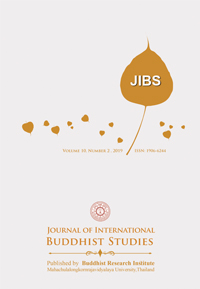Boonkumkhaoyai : The Thai-Isan Epitomic Model of Buddhist Economy and Dhammic Socialism
Keywords:
Boonkumkhaoyai, Thai-Isan, Epitomic, Model, Buddhist,Economy, Dhammic, SocialismAbstract
In Northeast Thailand, or Isan, there are twelve distinct ceremonies known as PrapheniHeetSibsong that mark the entire lunar calendar. Each of these ceremonies is an occasion for merit-making, observance of the precepts, and cultivation of morality (sīla), meditation (samādhi) and wisdom (paññā). Based mostly on Buddhist principles, each ceremony in the entire corpus of PrapheniHeetSibsong points towards a gradual progress along the spiritual path, and has since time immemorial formed the warp and woof of the traditional Isan way of life. Although Isan is generally regarded as the poorest and the most ‘backward’ region in the country, a close look at how the northeasterners have entwined their lives with the twelve-month tradition reveals the richness of the Buddhist ethico-religious and cultural heritage that has remained intact to the present day. In this paper we focus on one unique ceremony, Boonkumkhaoyai (previously known as “Boonkhunlarn”), literally translated into English as “merit-making by offering the giant paddy heap”, that marks the second lunar month and falls approximately in the month of January. It is an ancient traditional ceremony that is held at the end of the harvest s eason in order to create harmony and mutual co-existence among all people in the village. In Boonkumkhaoyai, villagers co-operate to form the giant paddy heap by donating unhusked rice for the purpose of supporting and promoting various projects related to community welfare, propagation of Buddhism and Isan culture. Viewed from the socio-ethical perspective, this particular agro-based ritualistic ceremony seems to epitomize the culture of merit-making ingrained in the traditional Isan way of life. Although merit-making in some urban and cosmopolitan settings has been adversely affected by the rapid modernization, consumerist culture and capitalistic mode of growth that took place in the last few decades, Isan people, on the other hand, have successfully preserved the culture of merit-making by still adhering to its pristine values and practicing it within the folds of PrapheniHeetSibsong. Therefore, merit-making still exists as a spontaneously thriving tradition and has not yet turned out to be a fe tish and a means to ‘bartering’ of merit. In this paper we analyze various socio-ethico principles that form the foundational base of Boonkumkhaoyai. Through our analysis we aim at showing that Isan peasantry’s inherent zeal to practice generosity at a communal level for the welfare of the entire community and society at large brings into fusion two distinct trends of the Buddhist weltanschauung, namely, Buddhist economy and Dhammic Socialism.
References
Buddhadasa, Dhammic Socialism, Bangkok: Thai Interreli- gious Commission for Development, 1993.ChobDesuankh oked.,Kawpaikabboon, Special Issue Jan – Mar,Khonkaen: Mahachulalongkornrājavidyālaya University, 2009.
Dipti Mahanta, “The Middle Way for Sustainable Development amidst Social Changes” in Buddhism for Sustainable Development and Social Changeed.,ThichNhatTu and ThichDucThien, Vietnam Buddhist University Series 21, Religion Press, 2014.
Eugene Watson Burlingame, trans. Buddhist Legends Part I, PTS, 1995.
Khammai Dhammasami and Dion Peoples ed., Buddhist Approach to Economic Crisis, UNDV Volume, Bangkok, 2009.
P.A. Payutto, Buddhadhamma, Albany: State University of New York Press, 1995.
______,Buddhist Economics, Bangkok: The National Identity Board, 1994.
______,DictionaryofBuddhism, Bangkok: Mahachulalongkornrajavidya- laya University Press, 2000.Samyuttanikāya,PTS Edition.
Walpole Rahula, What the Buddha Taught, Bangkok: Haw Trai Foundation, 1990.







